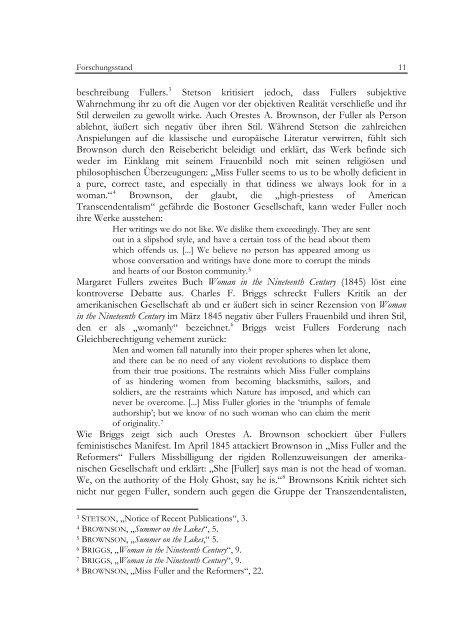Margaret Fullers transnationales Projekt : Selbstbildung, feminine ...
Margaret Fullers transnationales Projekt : Selbstbildung, feminine ...
Margaret Fullers transnationales Projekt : Selbstbildung, feminine ...
Sie wollen auch ein ePaper? Erhöhen Sie die Reichweite Ihrer Titel.
YUMPU macht aus Druck-PDFs automatisch weboptimierte ePaper, die Google liebt.
Forschungsstand 11<br />
beschreibung <strong>Fullers</strong>. 3 Stetson kritisiert jedoch, dass <strong>Fullers</strong> subjektive<br />
Wahrnehmung ihr zu oft die Augen vor der objektiven Realität verschließe und ihr<br />
Stil derweilen zu gewollt wirke. Auch Orestes A. Brownson, der Fuller als Person<br />
ablehnt, äußert sich negativ über ihren Stil. Während Stetson die zahlreichen<br />
Anspielungen auf die klassische und europäische Literatur verwirren, fühlt sich<br />
Brownson durch den Reisebericht beleidigt und erklärt, das Werk befinde sich<br />
weder im Einklang mit seinem Frauenbild noch mit seinen religiösen und<br />
philosophischen Überzeugungen: „Miss Fuller seems to us to be wholly deficient in<br />
a pure, correct taste, and especially in that tidiness we always look for in a<br />
woman.“ 4 Brownson, der glaubt, die „high-priestess of American<br />
Transcendentalism“ gefährde die Bostoner Gesellschaft, kann weder Fuller noch<br />
ihre Werke ausstehen:<br />
Her writings we do not like. We dislike them exceedingly. They are sent<br />
out in a slipshod style, and have a certain toss of the head about them<br />
which offends us. [...] We believe no person has appeared among us<br />
whose conversation and writings have done more to corrupt the minds<br />
and hearts of our Boston community. 5<br />
<strong>Margaret</strong> <strong>Fullers</strong> zweites Buch Woman in the Nineteenth Century (1845) löst eine<br />
kontroverse Debatte aus. Charles F. Briggs schreckt <strong>Fullers</strong> Kritik an der<br />
amerikanischen Gesellschaft ab und er äußert sich in seiner Rezension von Woman<br />
in the Nineteenth Century im März 1845 negativ über <strong>Fullers</strong> Frauenbild und ihren Stil,<br />
den er als „womanly“ bezeichnet. 6 Briggs weist <strong>Fullers</strong> Forderung nach<br />
Gleichberechtigung vehement zurück:<br />
Men and women fall naturally into their proper spheres when let alone,<br />
and there can be no need of any violent revolutions to displace them<br />
from their true positions. The restraints which Miss Fuller complains<br />
of as hindering women from becoming blacksmiths, sailors, and<br />
soldiers, are the restraints which Nature has imposed, and which can<br />
never be overcome. [...] Miss Fuller glories in the ‘triumphs of female<br />
authorship’; but we know of no such woman who can claim the merit<br />
of originality. 7<br />
Wie Briggs zeigt sich auch Orestes A. Brownson schockiert über <strong>Fullers</strong><br />
feministisches Manifest. Im April 1845 attackiert Brownson in „Miss Fuller and the<br />
Reformers“ <strong>Fullers</strong> Missbilligung der rigiden Rollenzuweisungen der amerikanischen<br />
Gesellschaft und erklärt: „She [Fuller] says man is not the head of woman.<br />
We, on the authority of the Holy Ghost, say he is.“ 8 Brownsons Kritik richtet sich<br />
nicht nur gegen Fuller, sondern auch gegen die Gruppe der Transzendentalisten,<br />
3 STETSON, „Notice of Recent Publications“, 3.<br />
4 BROWNSON, „Summer on the Lakes“, 5.<br />
5 BROWNSON, „Summer on the Lakes,“ 5.<br />
6 BRIGGS, „Woman in the Nineteenth Century“, 9.<br />
7 BRIGGS, „Woman in the Nineteenth Century“, 9.<br />
8 BROWNSON, „Miss Fuller and the Reformers“, 22.

















